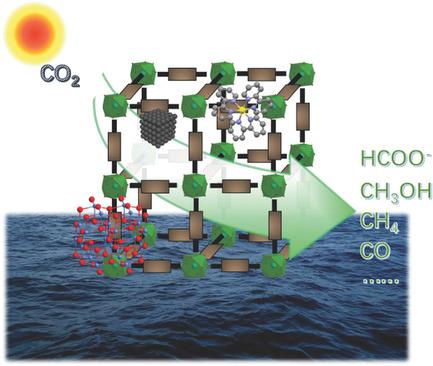当前位置:
X-MOL 学术
›
Adv. Mater.
›
论文详情
Our official English website, www.x-mol.net, welcomes your feedback! (Note: you will need to create a separate account there.)
Metal–Organic‐Framework‐Based Catalysts for Photoreduction of CO2
Advanced Materials ( IF 29.4 ) Pub Date : 2018-06-12 , DOI: 10.1002/adma.201705512 Rui Li 1 , Wang Zhang 1 , Kun Zhou 1
Advanced Materials ( IF 29.4 ) Pub Date : 2018-06-12 , DOI: 10.1002/adma.201705512 Rui Li 1 , Wang Zhang 1 , Kun Zhou 1
Affiliation

|
Photoreduction of CO2 into reusable carbon forms is considered as a promising approach to address the crisis of energy from fossil fuels and reduce excessive CO2 emission. Recently, metal–organic frameworks (MOFs) have attracted much attention as CO2 photoreduction‐related catalysts, owing to their unique electronic band structures, excellent CO2 adsorption capacities, and tailorable light‐absorption abilities. Recent advances on the design, synthesis, and CO2 reduction applications of MOF‐based photocatalysts are discussed here, beginning with the introduction of the characteristics of high‐efficiency photocatalysts and structural advantages of MOFs. The roles of MOFs in CO2 photoreduction systems as photocatalysts, photocatalytic hosts, and cocatalysts are analyzed. Detailed discussions focus on two constituents of pure MOFs (metal clusters such as Ti–O, Zr–O, and Fe–O clusters and functional organic linkers such as amino‐modified, photosensitizer‐functionalized, and electron‐rich conjugated linkers) and three types of MOF‐based composites (metal–MOF, semiconductor–MOF, and photosensitizer–MOF composites). The constituents, CO2 adsorption capacities, absorption edges, and photocatalytic activities of these photocatalysts are highlighted to provide fundamental guidance to rational design of efficient MOF‐based photocatalyst materials for CO2 reduction. A perspective of future research directions, critical challenges to be met, and potential solutions in this research field concludes the discussion.
中文翻译:

金属-有机框架基催化剂,用于CO2的光还原
将CO 2光还原为可重复使用的碳形式被认为是解决化石燃料能源危机并减少过量CO 2排放的一种有前途的方法。近年来,由于其独特的电子能带结构,出色的CO 2吸附能力和可定制的光吸收能力,金属有机骨架(MOF)成为与CO 2光还原相关的催化剂引起了广泛关注。本文首先介绍了基于MOF的光催化剂的设计,合成和CO 2还原应用方面的最新进展,首先介绍了高效光催化剂的特性和MOF的结构优势。MOF在CO 2中的作用分析了作为光催化剂,光催化主体和助催化剂的光还原系统。详细的讨论集中在纯MOF的两个组成部分(金属簇,例如Ti-O,Zr-O和Fe-O簇以及功能性有机连接基,例如氨基修饰,光敏剂官能化和富电子共轭连接基)和三个基于MOF的复合材料的类型(金属– MOF,半导体– MOF和光敏剂– MOF复合材料)。这些光催化剂的成分,CO 2吸附能力,吸收边缘和光催化活性被重点介绍,从而为合理设计基于MOF的高效CO 2光催化剂材料提供基本指导。减少。展望未来的研究方向,需要解决的关键挑战以及该研究领域中的潜在解决方案,从而完成了讨论。
更新日期:2018-06-12
中文翻译:

金属-有机框架基催化剂,用于CO2的光还原
将CO 2光还原为可重复使用的碳形式被认为是解决化石燃料能源危机并减少过量CO 2排放的一种有前途的方法。近年来,由于其独特的电子能带结构,出色的CO 2吸附能力和可定制的光吸收能力,金属有机骨架(MOF)成为与CO 2光还原相关的催化剂引起了广泛关注。本文首先介绍了基于MOF的光催化剂的设计,合成和CO 2还原应用方面的最新进展,首先介绍了高效光催化剂的特性和MOF的结构优势。MOF在CO 2中的作用分析了作为光催化剂,光催化主体和助催化剂的光还原系统。详细的讨论集中在纯MOF的两个组成部分(金属簇,例如Ti-O,Zr-O和Fe-O簇以及功能性有机连接基,例如氨基修饰,光敏剂官能化和富电子共轭连接基)和三个基于MOF的复合材料的类型(金属– MOF,半导体– MOF和光敏剂– MOF复合材料)。这些光催化剂的成分,CO 2吸附能力,吸收边缘和光催化活性被重点介绍,从而为合理设计基于MOF的高效CO 2光催化剂材料提供基本指导。减少。展望未来的研究方向,需要解决的关键挑战以及该研究领域中的潜在解决方案,从而完成了讨论。


























 京公网安备 11010802027423号
京公网安备 11010802027423号